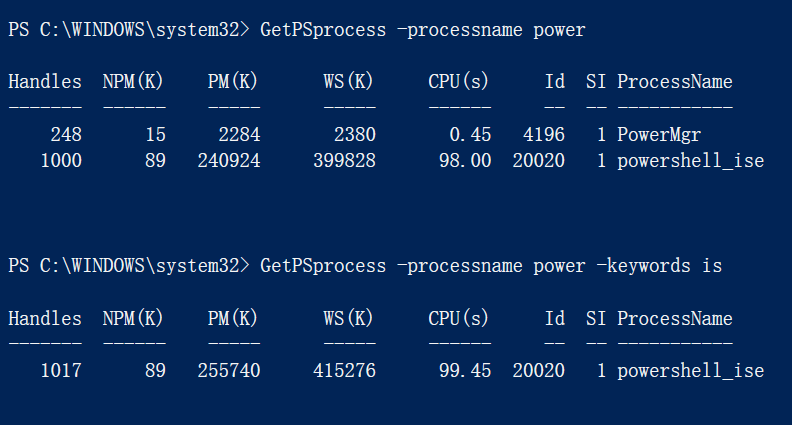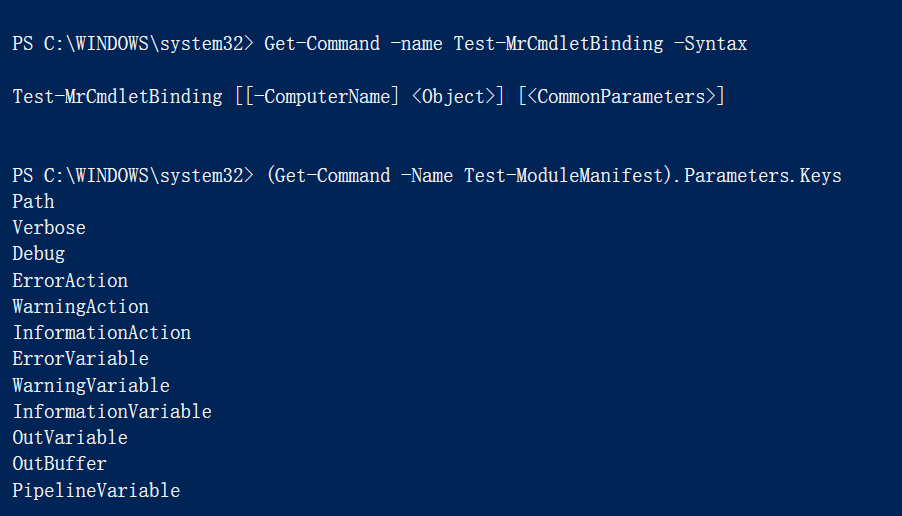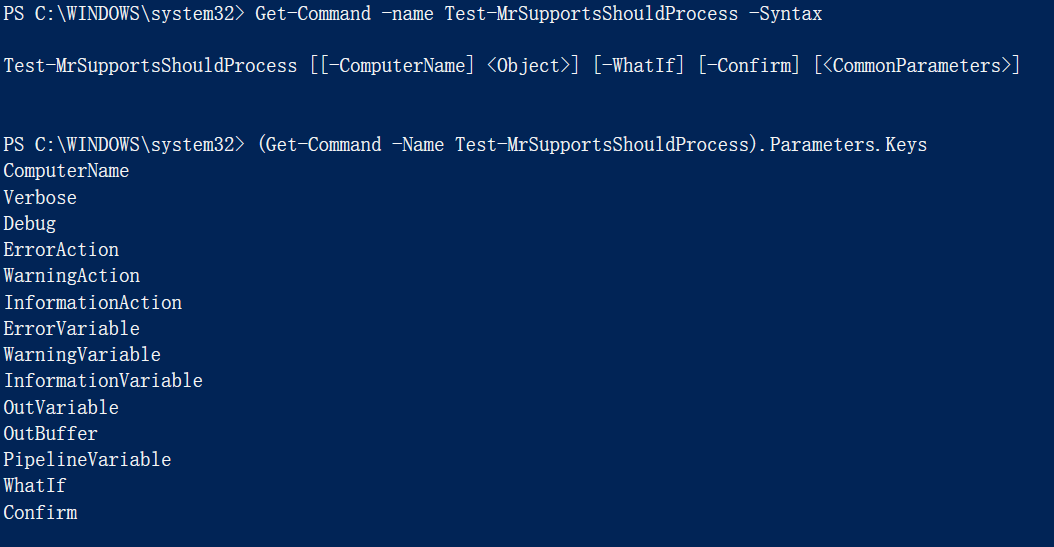PowerShell 函数
Powershell 中的函数使用关键字(function)声明,后面依次跟函数名称、左右大括号。函数将执行的代码包含在这些大括号中。
函数基本操作:
#创建函数 Function GetPSversion { $PSVersionTable.PSVersion } #调用函数,直接写函数名 GetPSversion #查看函数定义 $Function:GetPSversion #导出函数定义到文本 $Function:GetPSversion | Out-File C:\Code\GetPSversion.ps1 #删除函数 del Function:GetPSversion #查看内部定义函数: dir function: | ft -AutoSize
创建带参数的函数的三种方法#创建带参数的函数
Function GetPSprocess($processname)
{
Get-Process -Name "*$processname*"
}
Function GetPSprocess
{
param($processname)
Get-Process -Name "*$processname*"
}
#有默认参数值
Function GetPSprocess
{
param($processname='powershell')
Get-Process -Name "*$processname*"
}
#多个参数
Function GetPSprocess
{
param($processname,$keywords)
Get-Process -Name "*$processname*$keywords*"
}
调用函数:
直接使用函数名加参数方式
GetPSprocess
GetPSprocess power
GetPSprocess -processname power -keywords is

万能参数,无需声明:
Function GetPSprocess { Get-Process -Name "*$args*" }
高级函数
将PowerShell 中的函数转换为高级函数非常简单。函数与高级函数之间的区别是,高级函数具有多个自动添加到函数的通用参数。这些参数通常包括Verbose 和Debug
添加CmdletBinding 以将函数转换为高级函数。
function Test-MrCmdletBinding { [CmdletBinding()] #<<-- This turns a regular function into an advanced function param ( $ComputerName ) Write-Output $ComputerName } #通过Get-Command 向下钻取参数。 Get-Command -name Test-MrCmdletBinding -Syntax (Get-Command -Name Test-ModuleManifest).Parameters.Keys

SupportsShouldProcess 会添加 WhatIf 和 Confirm 参数 。 只有做出更改的命令需要这些参数。
function Test-MrSupportsShouldProcess { [CmdletBinding(SupportsShouldProcess)] param ( $ComputerName ) Write-Output $ComputerName }
现在有 WhatIf 和 Confirm 参数 。

参数验证
function Test-MrParameterValidation { [CmdletBinding()] param ( [string]$ComputerName ) Write-Output $ComputerName }
指定参数数据类型 为string ,所以不允许有逗号分隔。

强制指定参数 Mandatory
function Test-MrParameterValidation { [CmdletBinding()] param ( [Parameter(Mandatory)] [string]$ComputerNmae ) Write-Output $ComputerNmae }

如果需要参数有多个值,指定类型为string[]
function Test-MrParameterValidation { [CmdletBinding()] param ( [Parameter(Mandatory)] [string[]]$ComputerName ) Write-Output $ComputerName }

如果需要指定一个默认参数需要将ValidateNotNullOrEmpty 参数验证属性与默认值一起使用,不过不能与必需(Mandatory)参数一起使用!
function Test-MrParameterValidation { [CmdletBinding()] param ( [ValidateNotNullOrEmpty()] [string[]]$ComputerNmae = "s1" ) Write-Output $ComputerNmae }
默认将输出s1

使用使用 Write-Verbose 进行注释
function Test-MrVerboseOutput { [CmdletBinding()] param ( [ValidateNotNullOrEmpty()] [string[]]$ComputerName = $env:COMPUTERNAME ) foreach ($Computer in $ComputerName) { Write-Verbose -Message "Attempting to perform some action on $Computer" Write-Output $Computer } }

管道输入
若要接受按值显示管道输入,请为该特定参数指定 ValueFromPipeline 参数属性。
接受按属性名称显示的管道输入是类似的,但它是使用 ValueFromPipelineByPropertyName 参数属性指定的。
管道输入一次输入一个项,这类似于在 foreach 循环中处理项的方式。 如果要接受数组作为输入,则至少需要一个 process 块才能处理所有项。
function Test-MrPipelineInput { [CmdletBinding()] param ( [Parameter(Mandatory, ValueFromPipeline)] [string[]]$ComputerName ) PROCESS { Write-Output $ComputerName } }
BEGIN 和 END 块是可选的。 BEGIN 在 PROCESS 块之前指定,用于在从管道接收项之前执行任何初始工作。 了解这一点很重要。 在 BEGIN 块中无法访问通过管道传入的值。 END 块将在 PROCESS 块之后指定,用于在处理完通过管道传入的所有值之后进行清理。
错误处理
可采用多种不同的方法在 PowerShell 中处理错误。 Try/Catch 是处理错误的较新式的方法。将 ErrorAction 参数的值指定为 Stop,将非终止错误转换为终止错误 。
function Test-MrErrorHandling { [CmdletBinding()] param ( [Parameter(Mandatory, ValueFromPipeline, ValueFromPipelineByPropertyName)] [string[]]$ComputerName ) PROCESS { foreach ($Computer in $ComputerName) { try { Test-WSMan -ComputerName $Computer -ErrorAction Stop } catch { Write-Warning -Message "Unable to connect to Computer: $Computer" } } } }
基于注释的帮助
将基于注释的帮助添加到函数,以便你与之共享函数的人知道如何使用它们。
function Get-MrAutoStoppedService { <# .SYNOPSIS Returns a list of services that are set to start automatically, are not currently running, excluding the services that are set to delayed start. .DESCRIPTION Get-MrAutoStoppedService is a function that returns a list of services from the specified remote computer(s) that are set to start automatically, are not currently running, and it excludes the services that are set to start automatically with a delayed startup. .PARAMETER ComputerName The remote computer(s) to check the status of the services on. .PARAMETER Credential Specifies a user account that has permission to perform this action. The default is the current user. .EXAMPLE Get-MrAutoStoppedService -ComputerName 'Server1', 'Server2' .EXAMPLE 'Server1', 'Server2' | Get-MrAutoStoppedService .EXAMPLE Get-MrAutoStoppedService -ComputerName 'Server1' -Credential (Get-Credential) .INPUTS String .OUTPUTS PSCustomObject .NOTES Author: Mike F Robbins Website: http://mikefrobbins.com Twitter: @mikefrobbins #> [CmdletBinding()] param ( ) #Function Body }
本文参考: https://www.cnblogs.com/keepSmile/p/5821358.html
https://learn.microsoft.com/zh-cn/powershell/scripting/learn/ps101/09-functions?view=powershell-7.2
本文来自博客园,作者:Abstracthinking,转载请注明原文链接:https://www.cnblogs.com/Abstracthinking/p/16707432.html




